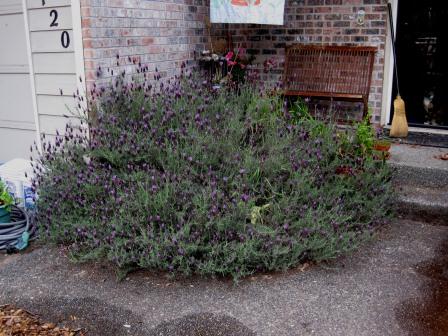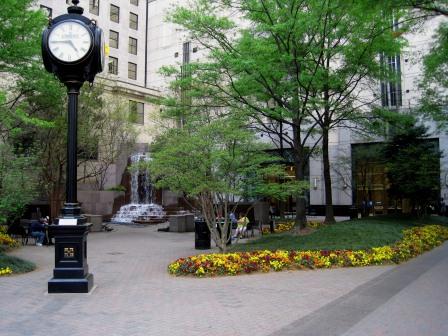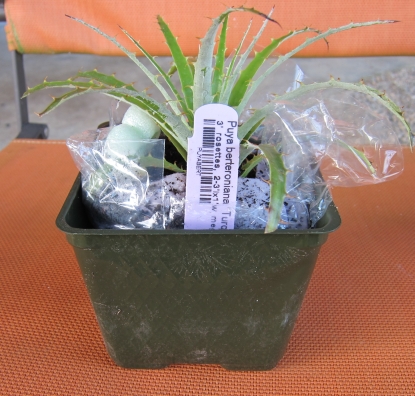
What a crazy spring! But it finally, finally came here to the Blue Ridge Mountains (Linda Chalker-Scott refers to them “speed bumps”).
My Ornamental Plants Production & Marketing class has been at work since early February, growing plants and marketing them at the Hort Club Plant Sale as part of their lab experience. Of course, they are completely at my mercy as to what they get to grow (bwuhh ha ha *evil hand wringing*). And due to their professor being a complete plant dork, they wouldn’t know a potted mum if it hit them upside the head. Not that there’s anything wrong with mums. But with so much fabulous stuff to choose from – they can just look that mum crop protocol up in a book if the need arises. They do get to experience a few zonal geraniums, but that’s only because the University’s past-President buys 50 red ones from us every year.
So what do they grow? Fabulous goodies you could never, ever find at a garden center in SW Virginia. Variegated Manihot esculenta. Dr. Cho’s newest Colocasia ‘Black Coral’ (gloss black with deep blue veins). Awesome landscape begonias such as ‘Gryphon’ and ‘Santa Cruz Sunset’. Fun annuals like Torenia and Osteospermum. Fifty-two different things – fairly ambitious, considering there are only 11 students. We fill a 40′ x 80′ house plus two “research” greenhouse sections that I commandeer the moment they come available.
My production students always start out the semester rather tentative, and then get more engaged as time goes on. We do a 2.5 day field trip across the state to visit top greenhouses, nurseries, and garden centers in early April. My gang comes home with a real appreciation of the hard work and long hours required to be successful; more important, perhaps, is their exposure to the tremendous passion and enthusiasm of the people in the business, many of who are alumni of our department.
SO…thirteen weeks later, we have greenhouses crammed full of really great plants,a bunch more ordered in from top area nurseries, an enthusiastic mob of customers with pent-up plant lust, and some very proud students.
And that’s the best part – the students get to/have to work with (gasp) the PUBLIC. Very disconcerting for some of them. The Plant Sale Chair for the club, who is also in my class, is a terrific student but a bit shy. Of course, he got the loudest customer of the day. She hollered “Hey, boo boo! Tell me about this plant! Sez here you grew it!” Ten shades of red later… I thought he was going to faint. But he did regain his composure and helped her with some other things. He also made me promise to never, ever tell his classmates what she called him.
But you’re not in my class 😉

Here comes “boo boo” with his very nice Cissus discolor (Rex Begonia Vine).
Names withheld to protect the totally embarrassed.

 For the uninitiated, a dibber or dibbler is simply a very sturdy, pokey thing, with a nice ergonomic handle. To use, simply scatter bulbs (never, ever in rows)…
For the uninitiated, a dibber or dibbler is simply a very sturdy, pokey thing, with a nice ergonomic handle. To use, simply scatter bulbs (never, ever in rows)…  Poke and plop. Went about 5″ to 6″ deep for these wee bulbs. Goes really fast once you’ve honed your dibbing skills.
Poke and plop. Went about 5″ to 6″ deep for these wee bulbs. Goes really fast once you’ve honed your dibbing skills. As a bulb-planting strategy, I like to leave them all uncovered until I’ve got the whole batch situated. Then make like a squirrel and cover the bulbs!
As a bulb-planting strategy, I like to leave them all uncovered until I’ve got the whole batch situated. Then make like a squirrel and cover the bulbs! Voila. Done in 60 seconds! Though I’ll probably forget where I planted them within 60 minutes (which does make for a pleasant surprise come spring time – “Oh look! Alliums!”)
Voila. Done in 60 seconds! Though I’ll probably forget where I planted them within 60 minutes (which does make for a pleasant surprise come spring time – “Oh look! Alliums!”)





 Lavender #2 before root pruning
Lavender #2 before root pruning












